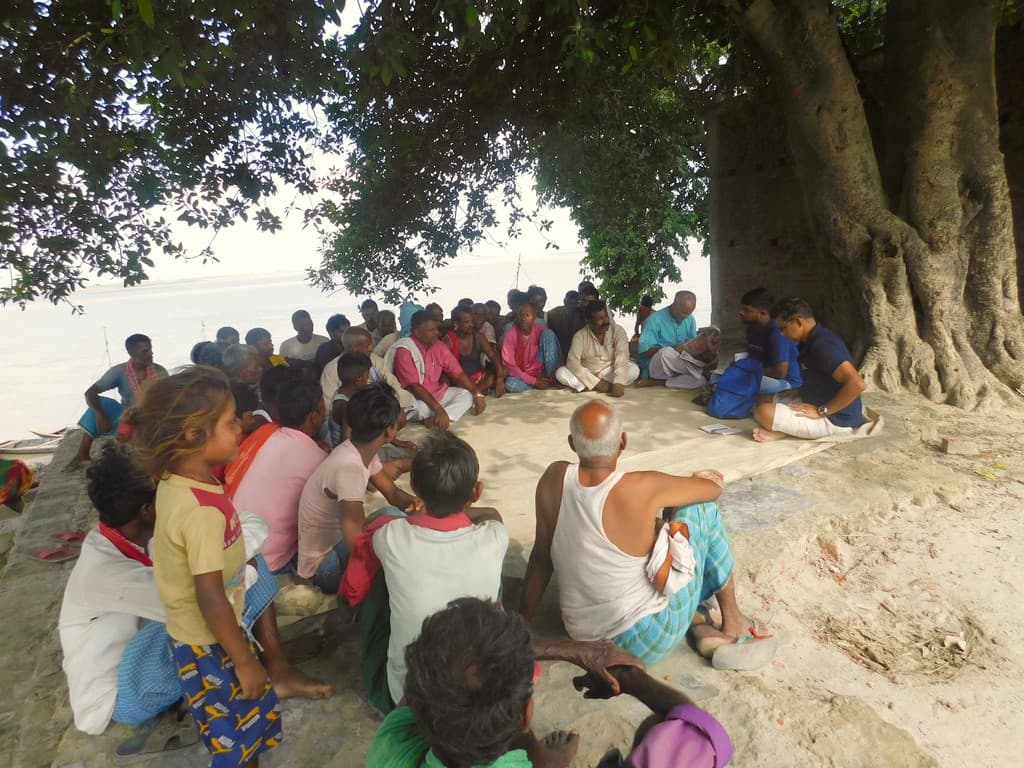I have been working in the riverscapes of Bihar for over 25 long years, for the conservation of river biodiversity, particularly the Ganges river dolphin, by trying to understand the complex web of relations between humans, animals, and the river itself. In all these years, I have interacted with many fishing communities living alongside rivers.

The author (extreme right) with fishers in Bihar. © Deepak Kumar Singh
These people have narrated to me many stories about their hard lives and daily struggles – where they face direct dangers to life from people who live by grabbing the fruits of others’ labours, where fish stocks continue to decline by the day, and the demands of life only keep on increasing. In this state of squalor, their only hope is to carry back to their families, every day, the fish catch they get after spending long hours out in the river. Apart from these pressures, they now face two new ones: the pushback from those concerned about wildlife conservation, and from nature itself, which is changing at a great speed thanks to man-made climate change. All these factors, as one can imagine, have been making it increasingly difficult for fishers to cope, resulting in a constant search for work far away from their homes, mostly to earn a basic living through largely informal and seasonal work as labourers in construction, farms, sand mining, plywood industries, or in fishing systems in water bodies in distant states. Such forced migration is a journey in foraging, a wandering for a purpose, and an exile for survival.
Even after hearing so many stories that are emotionally hard to digest, I realised in a recent field visit that there are also discoveries about humanity’s indomitable spirit and zest to be made here. In my conversations with fishers from Yadopur Pathara, a fishing settlement in the Gandak region of Gopalganj district, in Bihar, they told me stories about fishers from their group regularly covering long distances, of over 1,000 km. on foot to reach Lakhipur, a small town in Assam. These foot migrations used to happen about 40-50 years ago when railway and road connectivity was not as good as it is today. It would take the fishers five to six months to walk that distance. They would go there to labour under contractors involved in digging ponds. After completing the work there, the fishers would again walk back to their homes. The fishers further said that some people would even cycle to Kolkata for work. Today, in 2023, there still is one such person who walks to and from places in Bihar which are more than 100 km. from Gopalganj!
Many people walk once a year for pilgrimage. Many have had to walk or cycle long distances to reach their homes amidst the COVID-19 crisis and chaos. But this walk is different. I believe that migration has always been an integral part of the life of fishers. Perhaps their feet listen to the call of hope and begin their unending march. They say we are all migrants, but some people will always be more so than most others.
About the author: Subhasis Dey has been working closely with the riverine fishing communities since 1998, when he joined the Ganges river dolphin conservation project at the T.M. Bhagalpur University, Bhagalpur, Bihar. Subhasis is keenly interested in the ecological and sociological applications of research findings in order to identify solutions to help the development of fisherfolk and ensure community-level involvement in the sustainable conservation of riverine fisheries and biodiversity. He is part of WCT’s Riverine Ecosystems And Livelihoods (REAL) programme. Subhasis is also a Member of the IUCN Cetacean Specialist Group.
Disclaimer: The author is associated with Wildlife Conservation Trust. The views and opinions expressed in the article are his own and do not necessarily reflect the views and opinions of Wildlife Conservation Trust.
Your donations support our on-ground operations, helping us meet our conservation goals.
Related Links
- River Animals and River People: For a Shared Future
- Creatures Great And Small
- From Under Our Feet
- IUCN’s latest Red List Assessment of the Ganges river dolphin
- Wildlife Week – India’s Big Cats Under Threat
- Not-for-profit organisation working to reduce human-wildlife conflict wins UN award
